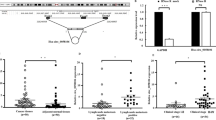Abstract
Purpose
The transcription factor TWIST is an important factor in regulation of the epithelial–mesenchymal transition (EMT), which represents the primary stages during the metastasis of tumors. To identify the role of TWIST in the regulation of metastasis in laryngeal carcinoma Hep-2 cells, we investigated whether the alteration of TWIST has an effect on the Hep-2 cells morphology and whether the alteration of TWIST has an effect on the expression of E-cadherin, N-cadherin as well as the ability of cell motion, migration, and invasion.
Methods
Morphological changes of Hep-2 cells that were transfected a mircoRNA against TWIST vector were observed by the reserved microscope. Reverse transcription-polymerase chain reaction was performed in order to examine the mRNA expression of TWIST, E-cadherin, and N-cadherin. Western blotting was performed to examine the protein expression of TWIST, E-cadherin, and N-cadherin. Cell motion ability was examined by Scratch-wound assay. Transwell™ chamber assays were used to determine cell migration and invasion.
Results
Transfecting a mircoRNA down-regulated TWIST expression at mRNA and protein levels. Down-regulation of TWIST expression induced morphological changes, such as the inversion of the EMT. Moreover, down-regulation of TWIST expression up-regulated E-cadherin and down-regulated N-cadherin expressions at mRNA and protein levels, respectively. Furthermore, we confirmed that down-regulation of TWIST expression decreased the motion, invasion, and migration ability of the Hep-2 cells.
Conclusions
Down-regulation of TWIST expression decreases migration and invasion of laryngeal carcinoma Hep-2 cells by regulation of the E-cadherin, N-cadherin expression.





Similar content being viewed by others
Abbreviations
- EMT:
-
Epithelial–mesenchymal transition
- HNSCC:
-
Head and neck squamous cell carcinoma
- DMEM:
-
Dulbecco modified eagle medium
References
Christofori G, Semb H (1999) The role of the cell-adhesion molecule Ecadherin as a tumour-suppressor gene. Trends Biochem Sci 24:73–76
Delmas V, Larue L (2004) Cadherins in the mammary gland and the melanocyte lineage. J Soc Biol 198:385–389
Eccles SA, Welch DR (2007) Metastasis: recent discoveries and novel treatment strategies. Lancet 369:1742–1757
Hazan RB, Phillips GR, Qiao RF, Norton L, Aaronson SA (2007) Exogenous expression of N-cadherin in breast cancer cells induces cell migration, invasion, and metastasis. J Cell Biol 148:779–790
Hirohashi S (1998) Inactivation of the E-cadherin-mediated cell adhesion system in human cancers. Am J Pathol 153:333–339
Hsu MY, Meier FE, Nesbit M, Hsu JY, Van Belle P, Elder DE, Herlyn M (2000) E-cadherin expression in melanoma cells restores keratinocyte mediated growth control and down-regulates expression of invasion related adhesion receptors. Am J Pathol 156:1515–1525
Huber MA, Kraut N, Beug H (2005) Molecular requirements for epithelial-mesenchymal transition during tumor progression. Curr Opin Cell Biol 17:548–558
Hugo H, Ackland ML, Blick T, Lawrence MG, Clements JA, Williams ED, Thompson EW (2007) Epithelial–mesenchymal and mesenchymal–epithelial transitions in carcinoma progression. J Cell Physiol 213:374–383
Jemal A, Thomas A, Murray T, Thun M (2002) Cancer statistics. CA Cancer J Clin 52:23–47
Kang Y, Massague J (2004) Epithelial-mesenchymal transitions: twist in development and metastasis. Cell 118:277–279
Kwok WK, Ling MT, Lee TW et al (2005) Up-regulation of TWIST in prostate cancer and its implication as a therapeutic target. Cancer Res 65:5153–5162
Kyo S, Sakaguchi J, Ohno S et al (2006) High Twist expression is involved in infiltrative endometrial cancer and affects patient survival. Hum Pathol 37:431–438
Lee JM, Dedhar S, Kalluri R, Thompson EW (2006) The epithelial–mesenchymal transition: new insights in signaling, development, and disease. J Cell Biol 172:973–981
Nieman MT, Prudoff RS, Johnson KR, Wheelock MJ (1999) N-cadherin promotes motility in human breast cancer cells regardless of their E-cadherin expression. J Cell Biol 147:631–644
Pyo SW, Hashimoto M, Kim YS, Kim CH, Lee SH, Johnson KR, Wheelock MJ (2007) Expression of E-cadherin, P-cadherin and N-cadherin in oral squamous cell carcinoma: correlation with the clinicopathologic features and patient outcome. J Craniomaxillofac Surg 35:1–9
Thiery JP (2002) Epithelial-mesenchymal transitions in tumour progression. Nat Rev Cancer 2:442–454
Tokes AM, Kulka J, Paku S, Szik A, Paska C, Novak PK, Szilak L, Kiss A, Bogi K, Schaff Z (2005) Claudin-1, -3 and -4 proteins and mRNA expression in benign and malignant breast lesions: a research study. Breast Cancer Res 7:R296–R305
Wheelock MJ, Shintani Y, Maeda M, Fukumoto Y, Johnson KR (2008) Cadherin switching. J Cell Sci 121:727–735
Xue C, Plieth D, Venkov C, Xu C, Neilson EG (2004) The gatekeeper effect of epithelial-mesenchymal transition regulates the frequency of breast cancer metastasis. Cancer Res 63:3386–3394
Yang J, Mani SA, Donaher JL, Ramaswamy S, Itzykson RA, Come C, Savagner P, Gitelman I, Richardson A, Weinberg RA (2004) Twist, a master regulator of morphogenesis, plays an essential role in tumor metastasis. Cell 117:927–939
Yu L, Li HZ, Lu SM, Liu WW, Li JF, Wang HB, Xu W (2009) Alteration in TWIST expression: possible role in paclitaxel induced apoptosis in human laryngeal carcinoma Hep-2 Cell line. Corat Med J 50:536–542
Yuen HF, Chan YP, Wong ML et al (2007) Up-regulation of TWIST in oesophageal squamous cell carcinoma is associated with neoplastic transformation and distant metastasis. J Clin Pathol 60:510–514
Acknowledgments
This work was supported in part Department of Science & Technology of Shandong province (03BS020) and by Shandong Province Outstanding Young Scientist Research Award Fund (bs2009yy018).
Author information
Authors and Affiliations
Corresponding authors
Additional information
Liang Yu and Hui-zheng Li contributed equally to this work.
Rights and permissions
About this article
Cite this article
Yu, L., Li, Hz., Lu, Sm. et al. Down-regulation of TWIST decreases migration and invasion of laryngeal carcinoma Hep-2 cells by regulating the E-cadherin, N-cadherin expression. J Cancer Res Clin Oncol 137, 1487–1493 (2011). https://doi.org/10.1007/s00432-011-1023-z
Received:
Accepted:
Published:
Issue Date:
DOI: https://doi.org/10.1007/s00432-011-1023-z




